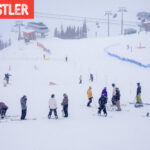Art Director Norm and Managing Editor Anne were giggling on a conference call the other day when I had to leave the conversation briefly to chase a black squirrel out of my office. During tomato-growing season, which for us this year extended into October, I’m at war around my attic office balcony with these proverbial flea-bitten varmints.
Normie, who grew up in Leamington, Ontario, as you all know the tomato capital of North America, seemed to take particular delight in hearing my tales of trapping the belligerent little thieves. Of course, my catch and release program includes sneaking the critter downstairs past a sleeping Labrador and taking a drive to the other side of the lake in Toronto’s High Park, near where one of many Ski Canada home offices lie in Ontario, Alberta and B.C.
When I rejoined the story meeting, Anne asked rightly “Don’t the squirrels just come back?” A valid question. In time, yes, I imagine they do, or others bagsie the vacant territory, but the lull can give me enough time in the late summer to harvest the crop. And on changing territories, I’ve decided squirrels, like skiers, learn to adapt.
It’s a late September day as I write this diatribe, in another Indian Summer, as in a New Delhi Indian Summer. The thermometer is reading over 30 degrees again and the heat in our non-air-conditioned house is going to my head—not the most inspiring weather when you need to be thinking about skiing. I’m reminded of some of the bizarre weather stories from last season and many others before it.
For those with short memories, while skiers in the west were enjoying a fantastic early start to what became a banner winter last year, we in the east were limping our way through the Christmas holiday on a thin layer of man-made left over from a week of cold weather in November. Refl ections of the early ’80s, which had even warmer winters. Indeed, by last January few ski areas were still open. Blue Mountain made national news for its closing and massive layoffs.
But it seemed just as pessimists began talking of winter never arriving—like the season B.C. had two years ago—the cold and snow suddenly came. Bull wheels began to turn again, ski shops scrambled to get sale signs up and the bean counters started amortizing Christmas season losses. In an ironic end-of-season twist, skiers at Blue (like those at Intrawest-sibling Whistler) were still on man-made, glacier-thick slopes the weekend of April 22—after the golf course had opened at the base.
Despite last year’s wacky weather, or perhaps because of it, Intrawest claims early bookings of ski holidays are way up after years of difficult-to-manage, last-minute mentality among travelling skiers. To ensure the accommodation, dates and price are available, the keenest among us, and that includes Ski Canada readers, are evidently changing habits and committing while the weather is still warm.
Merit Ski Vacations has noticeably left out some key information in its 2008 brochure: prices. Gone are the days when the leading tour operator would offer Saturday-to-Saturday pre-packaged ski holidays like a Jack Tar Village in the Dominican Republic. “Everything is customized now,” says Merit’s Katarina George. “We deal with the best resorts of Canada, the U.S., Europe—even Chile—and tailor details around the skier.” Knowledgeable online research by many clients is standard now, and tour operators have had to drastically change how they do business and offer more value than a do-it-yourself holiday. Merit will even work with flights secured on a client’s own airline reward plan.
Last year our family’s big trip, booked in October, was to Austria and Italy (the story begins on page 50) in what turned out to be Europe’s warmest winter in 300 years. As you’ll see, our adaptation to the “marginal conditions” wasn’t so hard to take. Ultimately, weather is what we all love to talk about, though, and who better to take a fresh look on climate change than resident Ski Canada curmudgeon George Koch.
Following a very convincing primer on cat-skiing (page 28), something, by the way, Canadian skiers are embracing lovingly now after decades of almost national disinterest, George’s take on global warming and how much skiers need to be prepared to adapt to changes around us begins on page 76. George might not make you feel all warm and fuzzy inside, but he might change the way you think about the future of our sport.



